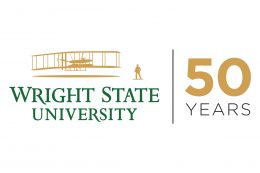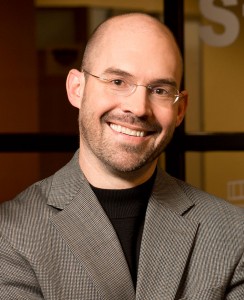
From left: Amit Sheth, professor of computer science and engineering and executive director of the Kno.e.sis Center, and Alan Smith look on as Jeremy Brunn displays data gathered by Twitris on a digital monitor.
Former construction worker Jeremy Brunn used to spend his summer months performing backbreaking work, such as installing roofing shingles in 95-degree weather.
Last summer, Brunn and Alan Smith, his colleague at Wright State’s Kno.e.sis Center, helped transform a sophisticated software tool into a Dayton startup company.
Brunn’s transformation from pounding nails to commercializing technology started when he decided to lay down his hammer and pick up a textbook on programming languages.
“So far, coming to Wright State has been one of the better decisions I’ve made in my life,” he said. “I’m grateful that Wright State was here for me. I can’t even imagine what I would have done with my life if I hadn’t decided on this path.”
His decision point came shortly after the 2008 crash in the housing market. He and his wife had just become proud parents of their second child.
“I knew I couldn’t provide steady support for my family in the construction industry. I read a Forbes article which predicted that computer science would be one of the hottest growth jobs in the future,” Brunn said. “I’ve always enjoyed working with computers. When I was 10, I programmed a computer to check my math homework. So, computer science is what I decided on. And once I did, I went all in.”
After earning a bachelor’s degree in computer science from Wright State, Brunn decided to continue on the path to earn a master’s degree.
“My kids were one of my biggest motivations for staying in school,” he said. “My son was born just before I started here, and I wanted to provide stability for my family.”
Smith had a similar motivation for pursuing a master’s degree in computer science at Wright State — parenthood.
“When I had my son, I made a lifelong commitment to do best by him, which meant not giving up on my educational goals,” said Smith, who also graduated from Wright State with a bachelor’s in computer science.

Amit Sheth, left, and James Mainord, co-founders of Cognovi Labs.
Together, Brunn and Smith became two important members of the Kno.e.sis team that transformed Twitris into a Dayton-based startup company.
The product of years of research by Amit Sheth, Kno.e.sis executive director, and several of his Ph.D. students, Twitris provides actionable insight into social media content, connecting real-time Twitter and other social media content with relevant news, Wikis and linked open data as background knowledge for deeper and more precise insights of collective social media intelligence.
Twitris provides insight in three different dimensions: Spatio-temporal-thematic (where, when, what); people-content-networking (who and how); and emotion-sentiment-intent (perceptions, actions and impact). This combination of data and insight into social media content helps provide actionable information and better decision making for the end user.
Twitris attracted a potential licensing partner, Ikove Venture Partners, to explore the marketability of the software tool with researchers at Wright State’s Kno.e.sis Center.
“We recognized that Twitris was a powerful tool, but the challenge was making this tool accessible to a non-computer scientist,” said James Mainord, COO of Ikove Venture Partners and Cognovi Labs.
Ikove asked the Kno.e.sis team to help the firm unlock the power of Twitris for their targeted end users — a branding executive at Disney, a hedge fund manager, a political campaign or a social media marketing manager at Wendy’s.
 Therein lay the challenge for Brunn and Smith.
Therein lay the challenge for Brunn and Smith.
“We flew in potential investors from New York City and South America to attend our weekly meetings with the Twitris commercialization team, and every week, we’d say, ‘This is interesting, but can Twitris do this? Can it show it me this information in this format? Can it update even faster?’” said Mainord.
“Our investment team was extremely thorough with their examination of the Twitris tool,” said Mainord. “We gave Jeremy and Alan new technical challenges every week, and every week, they overcame every challenge we laid before them.”
The behind-the-scenes work of Brunn, Smith and the rest of the Kno.e.sis team started to generate national publicity. TechCrunch, a business blog focusing on startup and investment news, wrote several articles on the innovative Wright State-developed technology. On June 29, 2016, TechCrunch posted a glowing article on the use of Twitris to accurately predict the outcome of the contentious Brexit vote using sophisticated social media analytics.
Based on the power of Twitris and the performance of the Kno.e.sis team, Ikove licensed the Twitris technology and, in the fall of 2016, launched a new Dayton-based company, Cognovi Labs.
“In business, timing is everything. We measure things like ‘manufacturing velocity’ and ‘speed to market,’” Mainord said. “What’s amazing about Jeremy, Alan and the rest of the Kno.e.sis team is that they understand this.”
“If they say something will get done, you know it will get done,” said Mainord. “That’s the highest compliment you can say about someone.”
Sheth, who serves as Brunn’s and Smith’s adviser, said he’s not surprised by the feedback on his students.
“When I’m working with my students, I often feel like President Kennedy making the commitment that an American will land on the moon,” Sheth said. “I know there will be a lot of tough, technical challenges, but ultimately, I’m confident that our students will find a creative solution, and they will succeed.”
Barbara H. Kenny, program director for the National Science Foundation’s Partnerships for Innovation Program, said she was pleased that Twitris has made the commercial leap.
“The National Science Foundation’s Partnerships for Innovation Program is an initiative designed to support the transition of NSF-funded fundamental research into market-valued solutions,” Kenny said. “We are very pleased with the Wright State team’s ability to transition its NSF-funded Twitris technology into a startup company.”

Nathan Klingbeil, dean of the Wright State College of Engineering and Computer Science
Nathan Klingbeil, dean of the Wright State College of Engineering and Computer Science, said he is proud of the graduate students’ contribution to the Twitris commercialization success story — but not surprised.
“We pride ourselves on making high-quality engineering and computer science education accessible to students from all walks of life,” Klingbeil said. “The fact that a former construction worker can come to Wright State, earn both a bachelor’s and master’s degree in computer science and play a critical role in launching a new, high-tech company is impressive, but this is what we’ve grown to expect from our students.”
“The remarkable success of Jeremy, Alan, Dr. Sheth and the Twitris commercialization team provides further testimony to our collective emphasis on access, affordability, and preeminence in engineering and computer science education,” Klingbeil said.
The commercialization of Twitris was supported by Wright State’s Office of Technology Transfer, which was established in 2001 as a division under the office of Vice President for Research. The mission of the technology transfer office is to assist and guide students, faculty, and staff to commercialize the university’s intellectual property to benefit society and the community. The office works to get inventions legally protected and then find commercial partners to take them to market by creating non-confidential summaries of the inventions and contacting parties that might be interested.
Wright State became an independent institution in 1967 and has grown into an innovative leader in the Dayton region and beyond, capturing the spirit of the university’s namesakes, Wilbur and Orville Wright, who invented the world’s first successful airplane from their Dayton bicycle shop. It celebrates its 50th anniversary as an independent public university in 2017, culminating with a special Homecoming celebration Sept. 29 through Oct. 1.

 Wright State University Foundation awards 11 Students First Fund projects
Wright State University Foundation awards 11 Students First Fund projects  Gov. DeWine reappoints Board Treasurer Beth Ferris and names student Ella Vaught to Wright State Board of Trustees
Gov. DeWine reappoints Board Treasurer Beth Ferris and names student Ella Vaught to Wright State Board of Trustees  Joe Gruenberg’s 40-Year support for Wright State celebrated with Honorary Alumnus Award
Joe Gruenberg’s 40-Year support for Wright State celebrated with Honorary Alumnus Award  Wright State’s elementary education program earns A+ rating for math teacher training
Wright State’s elementary education program earns A+ rating for math teacher training  Wright State’s Calamityville hosts its largest joint medical training operation
Wright State’s Calamityville hosts its largest joint medical training operation 